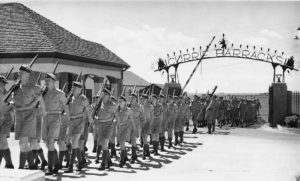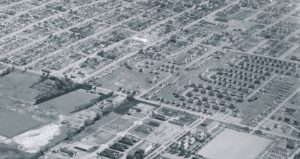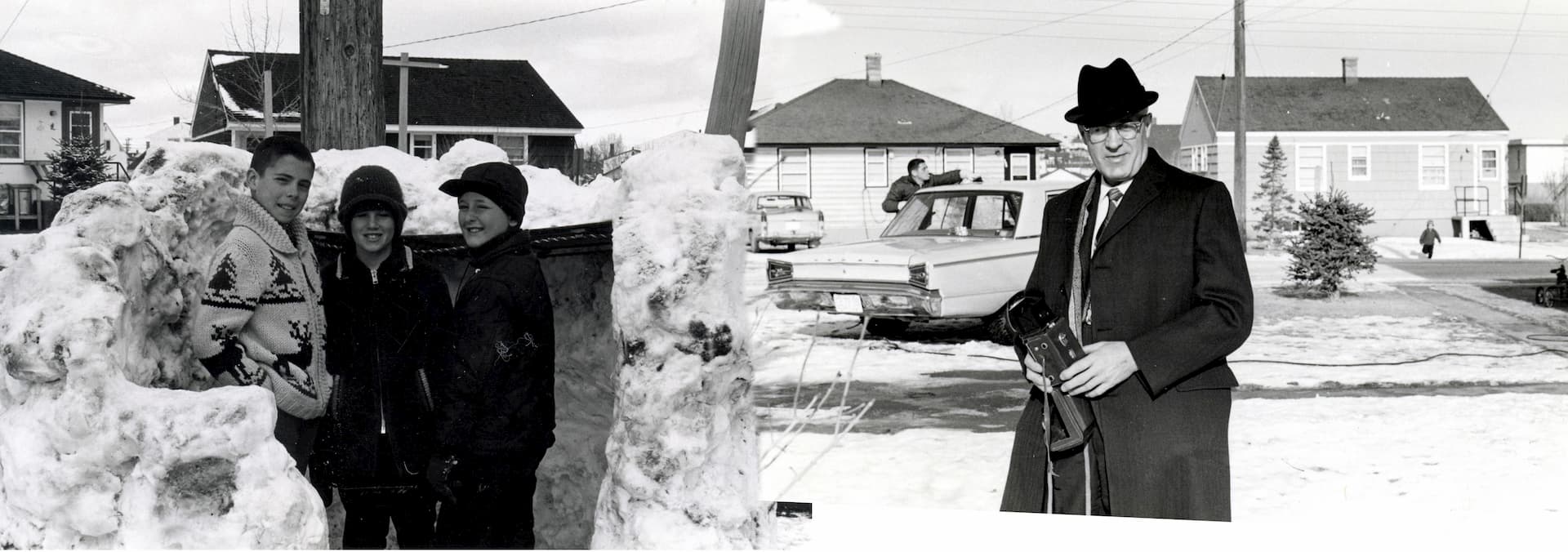The communities of Marda Loop have a long military history. Many who served and gave their lives for Canada trained, worked, shopped and lived in these neighbourhoods.

PPCLI marching out the main gate in the 1950s.* (Sourced from www.militarybruce.com)
The lands that later became Currie Barracks were first used for militia training during the Great War. Construction of Currie Barracks began in 1934 as a Depression-era relief project to employ workers. At the time, South Calgary was a quiet neighbourhood on the edge of the city, ringed by the South Calgary streetcar loop, with King Edward School in the middle. In his 1975 memoir of being a young boy in old South Calgary**, John Grant recalls that all of a sudden the local kids were joined at school by the children of military families. The arrival of the base also changed the area from the bucolic neighbourhood of Grant’s boyhood to a more interesting place – as he cheekily described:
“Now all the teen-age boys began hanging around the barracks. We were all impressed by the uniforms, the horses and the soldiers. The young ladies of South Calgary were also impressed by the soldiery but for different reasons. Later on, the RCAF types arrived and now the girls were thrilled beyond measure…”

Garrison Woods and Marda Loop area in 1963. The square field in the middle is where the Safeway is today. (Photo: University of Calgary Archives)
As entertaining as the military presence was for the local kids, World War II was deadly serious business. Currie Barracks and the airbase at Lincoln Park was a hive of activity. To serve thousands of soldiers the South Calgary streetcar ran at a 10-minute-plus frequency from 6 a.m. to after 1 a.m. with a “night owl” service. A shuttle bus ran the short distance from the barracks to the closest streetcar stop at 34th Avenue and 20th Street, the corner where young John Grant lived. All of this wartime activity seeded the little commercial district that later became Marda Loop.
Shortly after the war, Calgary experienced a boom. South of 34th Avenue and east of 20th Street, the new neighbourhood of Altadore spread across the prairie and was soon filled with young families. On the west side of 20th Street, the Defense Department built the Permanent Married Quarters (PMQs) for military families. In the Cold War years that followed, members of Calgary’s military community served in Korea and on many peacekeeping missions. Soldiers and their families were part of South Calgary and Altadore for decades, attending school, shopping in local shops, and seeing the movies at the old Marda (later Odeon) Theatre. No doubt many soldiers got their tattoos at Smilin’ Buddha!

Some residents of Somme Crescent circa 1960s. (Courtesy of the 192 Somme Crescent Currie PMQ’s CFB Calgary 1961-69 FB page.)
The relationship wasn’t always smooth. In 1980 there was controversy when a group of South Calgary business people complained that the CANEX store on the base – a general store for military personnel – was competing with private businesses in the area by selling to civilians. The local business group went on to found the Marda Loop BRZ in 1984 and launch the annual Marda Gras. Around the same time, supporters of Calgary’s military history founded The Museum of the Regiments, which has grown into The Military Museums, the second largest military museum in Canada.
In 1995 the new federal government announced that CFB Calgary would be closing within three years. At the time this was a big blow to Marda Loop. But the business community persevered, and the Canada Lands Company was very successful in redeveloping the Currie PMQs into Garrison Woods. By the early 2000s, the business district had expanded around new Safeway location and continued to thrive as thousands of new permanent residents moved into Garrison.

Many PMQ houses were moved, refurbished and sold to new owners in Garrison Woods. (Source: Canada Lands/CMHC)
Lest we forget, the reminders of our military history are all around us: From the historic street names, monuments and interpretative walk, to the refurbished military housing that is salted throughout the community, and even the historic displays on the front of the Safeway. Marda Loop remembers.

Still marching in Marda Loop, July 25, 2019, by the Petro Canada
———————————-
P.S. Do you have corrections or additions to this story? Do you have photographs, old news clippings or a tale to tell of the relationship between the Base and the Marda Loop area? Please get in touch with us at info@visitmardaloop.com. We would love to hear from you. Find out more about the Marda Loop History Project
* Note that the image of soldiers marching under the sign is reversed so that viewers of this page can read “Currie Barracks”; it looks like the soldiers are marching west into the Base from 24th Avenue (now Crowchild Trail).
**John Grant’s recollections are from “Vignettes of Old South Calgary” in Volume 1, Past and Present: People, Places and Events in Calgary. Calgary: Century Calgary Publications, 1975.